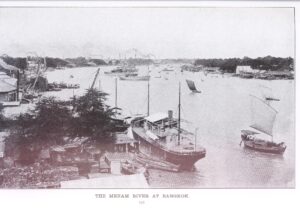Incubation
"Socio-economic change and seasonality in modern Southeast Asia"
R4-5 1-3 (R4 AY2022)
| Project Leader | Masahiro IKEDA (Okayama Shoka University, Faculty of Economics) |
| Collaborators | Shohei OKUBO(The University of Tokyo, Graduate School of Humanities and Sociology) Atsushi OTA(Keio University, Faculty of Economics) Ichiro KAKIZAKI(Yokohama City University, International College of Liberal Arts) Akiyuki KAWASAKI(The University of Tokyo, Institute for Future Initiatives) Atsushi KOBAYASHI(Kyoto University, Center for Southeast Asian Studies) Hideaki SUZUKI (National Museum of Ethnology, Department of Globalization and Humanity) Tomoko SHIROYAMA(The University of Tokyo, Graduate School of Economics) Ryuto SHIMADA(The University of Tokyo, Graduate School of Humanities and Sociology) Kaoru SUGIHARA(Research Institute for Humanity and Nature, Research Department) Yoshihiro TAGA(Tohoku Gakuin University, Faculty of Letters) Takeshi NISHIMURA(Kansai University, Faculty of Economics) Jun MATSUMOTO(Tokyo Metropolitan University, Graduate School of Urban Environmental Sciences) Fumiharu MIENO(Kyoto University, Center for Southeast Asian Studies) Toshiyuki MIYATA(Tokyo University of Foreign Studies, Graduate School of Global Studies) |
| Research Project | Socio-economic change and seasonality in modern Southeast Asia |
| Countries of Study | Indonesia, Singapore, Thailand, Vietnam, Malaysia, Myanmar |
Outline of Research
This project explores how seasonal fluctuations have changed in modern Southeast Asia, where natural environments have inherently constrained and defined regional economic activities. Seasonality here refers to natural phenomena, such as typhoons, precipitation, and changing river water levels, which affect production activities, regional labor mobility, short-term fluctuations in commercial and financial transactions, and so on. The project will examine how economic agents have responded and interacted with seasonality, and proposes a fresh look at socio-economic transformation in modern Southeast Asia through this keyword. The project members are researchers of history, economic history, economics, climatology, and hydrology, and thus the theme will be discussed from diverse viewpoints. The project members aim to further develop interdisciplinary collaborative research after this project.
Purpose of Research, Its Significance and Expected Results, etc.
The purpose of the project is to capture changes in the seasonality of economic activities in Southeast Asia from the 19th to the early 20th centuries using quantitative data and historical documents. During this period, Southeast Asia witnessed a drastic economic transformation, including trade liberalization, introduction of modern technology, incorporation into international markets, and market integration. These changes had a significant impact on the socio-economy of the region, which is profoundly entangled in the tropical monsoon and oceanic climate.
By focusing on seasonality, this research quantitatively, qualitatively, and visually identifies changes in various aspects of the socio-economy and clarifies interconnections among them. By accessing high-frequency data such as exchange rates and trade volumes from newspapers and periodicals published from the early 19th century, we can capture long term seasonal fluctuations. Moreover, from the mid-19th century, Western colonial authorities investigated and documented the geographies, water regimes, and climates of their colonies, publishing data on typhoon trajectories, temperature, humidity, precipitation, and water levels of main rivers. With these official records, we can visualize the interconnections between natural environments and local economies through hydro-climatological analyses.
The project will promote dialog among economic historians of Southeast Asia and associates from other regions and disciplines and stimulate discussions from various perspectives. Participation of natural scientists of climatology and hydrology can transcend academic boundaries to provide new insights into the relationships between natural seasonalities and local economies.
It is expected that the project will illuminate new aspects of Southeast Asia’s modern socio-economic transformation, thus deepening our understanding of the region. At the same time, participants will explore more specific and broader research topics to build upon this project and further develop future collaborative research.
![Photo 1: The cover of Tables des marées des colonies françaises des mers de Chine, in which the daily water level of the Mekong River is recorded.
[Source] Tables des marées des colonies françaises des mers de Chine, 1910, Service Hydrographique de la Marine de la France.](https://gcr.cseas.kyoto-u.ac.jp/wp-content/uploads/2022/11/r4-1-3_ikeda2-665x1024.jpg)
The cover of Tables des marées des colonies françaises des mers de Chine, in which the daily water level of the Mekong River is recorded.
[Source] Tables des marées des colonies françaises des mers de Chine, 1910, Service Hydrographique de la Marine de la France.
![Photo 2: Steamships and sailboats at Bangkok port.
[Source] Wright, Arnold & Oliver T. Breakspear ed. [1994] (1903) Twentieth Century Impressions of Siam: Its History, People, Commerce, Industries, and Resources. Bangkok, White Lotus (reprint).](https://gcr.cseas.kyoto-u.ac.jp/wp-content/uploads/2022/11/r4-1-3_ikeda1-1024x731.jpg)
[Source] Wright, Arnold & Oliver T. Breakspear ed. [1994] (1903) Twentieth Century Impressions of Siam: Its History, People, Commerce, Industries, and Resources. Bangkok, White Lotus (reprint).

